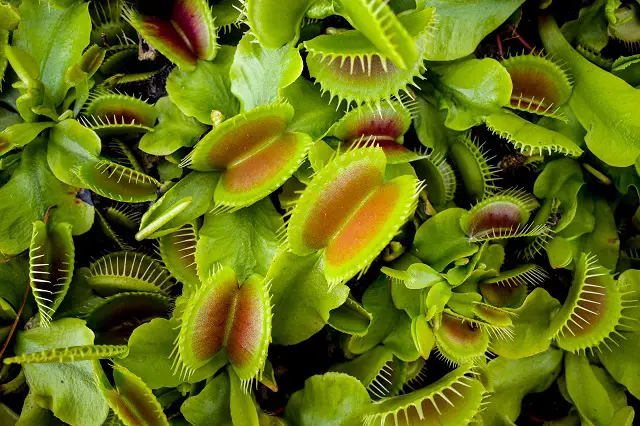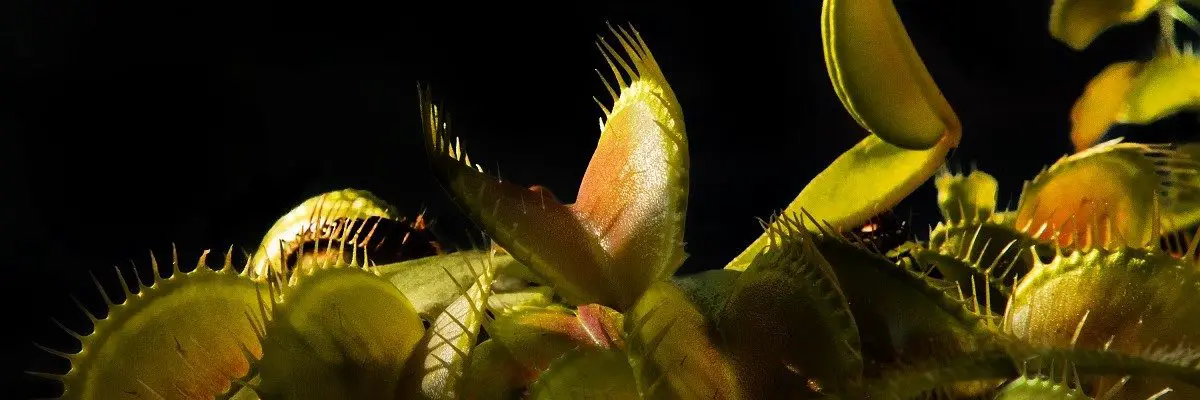A Venus Flytrap can get as big as 5-6 inches. With good care, your plant will reach its full size of about 13 cm or 5 inches in circumference if it continues to grow well for a few years. Please note that we are talking about the full plant growing to that size! Not its traps. Leaf traps may have a length of a couple of centimeters, not more than 3 centimeters (1 inch). A marginal plant will have about four to eight traps at any given time. Your plant can also produce up to 20 large traps in really good conditions.
North Carolina and South Carolina are native to Venus flytraps. Still, some other states have introduced them, including Florida and New Jersey. The National Wildlife Federation reports that they are attracted to the moist, acidic soil found in the understory of forests. High humidity and sun are also necessary for them to thrive.
The life cycle of these plants begins when they produce tiny black seeds that turn into seedlings. When plants are young, they grow rapidly during their first four years. The plant reaches maturity at the end of the fourth or fifth year. When the plant reaches maturity, it also begins to produce flowers every year. As the plant grows older, its growth rate will slow down. Some traps are only a few millimeters long. The average size of Venus flytraps grown by carnivorous plant owners sometimes exceeds 1-inch.
How big can a Venus flytrap get indoors?
While some Venus flytrap cultivars grow larger than an inch and a half, most grow only an inch or two high and wide inside and about 4 inches wide for the plant itself.

How do I make my Venus flytrap bigger?
| The Right Pot |
|---|
| If the pot is not large enough, Venus flytraps will not be able to grow as much as they should. The Venus flytrap is best suited to a wider container since it tends to cling to the ground. It requires a container with a diameter of at least 4 to 5 inches (10.5 – 12.7 cm) and a depth of at least 6 inches (15.24 cm) for an adult Venus flytrap to flourish. Furthermore, keep in mind that container depth is one of the most critical factors. The roots of Venus flytraps grow vertically. Their growth will be drastically limited if there isn’t enough vertical space. Worrying about the pot size when growing seedlings or young Venus flytraps is unnecessary. With time, the plant will need much larger pots. |
| Do Not Let Your Venus Flytrap Flower |
|---|
| Flowering occurs in the spring for Venus flytraps. Venus flytraps produce their flowers for reproduction. Venus flytraps should have their flower stalks removed before they flower to keep them healthy and promote growth. Your plant won’t be damaged directly by flower production, but it will be significantly weaker. These flowers take a lot of energy to produce yearly for a Venus flytrap. That energy can be used for growing. All plants produce several flowers during their growing season. As they are cylindrical structures (different from regular leaves), you can easily recognize the flower stalks. Most carnivorous plant growers recommend cutting off flower stalks as soon as you see them if you do not plan to harvest seeds. The sooner you remove them, the better since they consume the most energy. The flowering period is also discouraged for first-time Venus flytrap owners since they can make several mistakes. Plants can die under improper growing conditions, especially after flowering, when the plant has significantly weakened. |
| Feed Your Venus Flytrap |
|---|
| Venus flytraps can survive for months or even years without eating anything. They do this through photosynthesis, making their own food. In contrast, eating bugs can enhance the growth and development of your plants. Because their environment is devoid of nutrients, Venus flytraps have evolved into successful predators. As a result of not obtaining nutrients from the soil, they developed trapping mechanisms to catch bugs. The insects and arachnids they eat are essential elements that boost their diet. Although they’re not essential for plant survival, these elements help boost their diet. Therefore, they can be useful as supplements. |
| Prune the Black Leaves Of Your Venus Flytrap |
|---|
| Venus flytraps constantly change their leaves. New leaves emerge from the center of the bulb when the old leaves turn black and wither. As a result of microorganisms in the soil, black leaves decompose at a faster rate in the wild. However, a single dead leaf can take months to decompose in a plant pot. Venus flytraps need to trim their black leaves periodically to avoid overcrowding and promote new leaf growth. Trimming a single plant every week is unnecessary, but monthly trimming can help with its overall health. Furthermore, trimming black leaves will eliminate extra weight from your plant and prevent overcrowding. You will have to support the extra weight of the attached leaves since the plant is still growing. |
| Avoid Soil Compression |
|---|
| If soil is set in a pot for a long time, it will become more compressed, especially if it is watered frequently. Venus flytrap roots will have difficulty expanding if the soil is highly compressed. Periodically report your plant to prevent soil compression. Venus flytraps should be repotted once a year to avoid ground compression. After repotting for a few weeks, plants will be weak, but they will recover and flourish in fresh soil. At the end of the dormant period, Venus flytraps should be repotted, so they start the growing season in fresh soil. |
How tall is the tallest Venus Fly Trap?
Venus flytraps can grow up to a height of one foot. A 12-inch stem sprouts from the plant in early spring, bearing clusters of white cup-shaped flowers. In midsummer, specialized leaves, called traps, appear.


